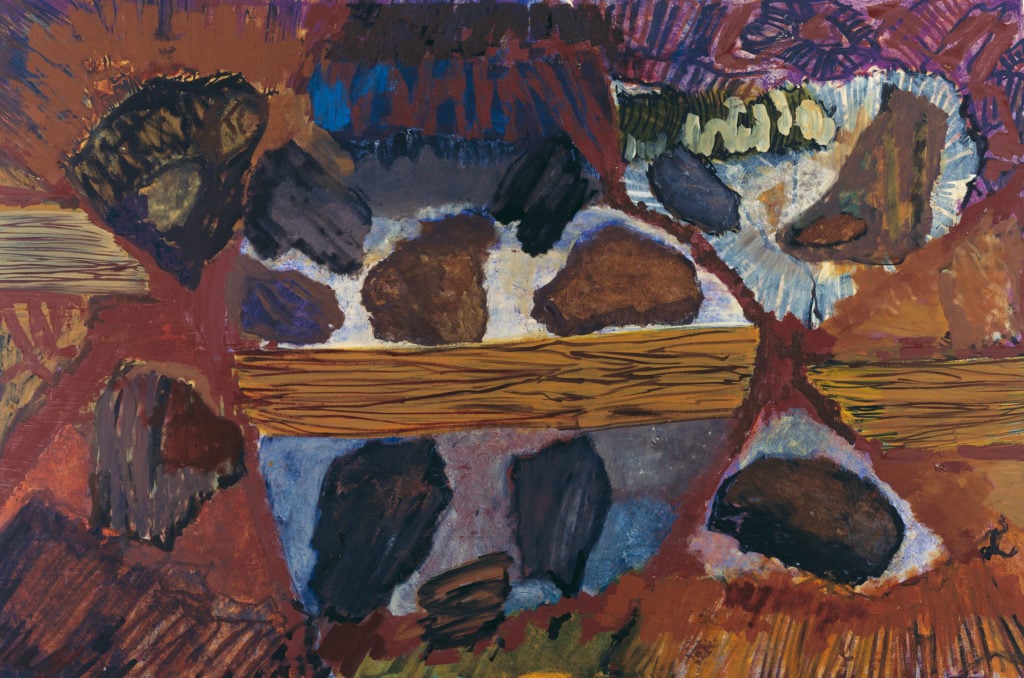People
Per Kirkeby, Polymathic Danish Artist Who Mixed Neo-Expressionism and Nature, Has Died
The painter, poet, filmmaker and sculptor was 79 years old.

The painter, poet, filmmaker and sculptor was 79 years old.

Naomi Rea

Per Kirkeby, the Danish neo-expressionist painter, poet, filmmaker, and sculptor, died on May 9 in Copenhagen, his gallery Michael Werner confirmed. He was 79 years old.
Born in 1938, Kirkeby received a masters degree in arctic geology from the University of Copenhagen in 1964, taking part in two expeditions to Greenland, in 1958 and 1962. This unusual background was a possible influence on his art: semi-abstract paintings influenced by his interest in geology.
Kirkeby’s work is represented in the public collections of global institutions including Tate in London, the Metropolitan Museum of Art in New York, and Paris’s Centre Pompidou. It has appeared in international exhibitions such as the Venice Biennale, where he represented Denmark in 1976 and was included in the 1980 edition, and documenta, where he was included in both its 1982 and 1992 editions.

Per Kirkeby, Untitled (2005). Courtesy Michael Werner Gallery, New York and London.
Writing for the Tate on the occasion of Kirkeby’s 2009 retrospective, the curator Robert Storr praised the expansiveness of the Danish artist’s vision:
In an age when simple contraction was the starting point and heightened contradiction the end point of so much work, Kirkeby has focused if not on synthesis, then on balancing different media in a mutually enhancing tension. The results, which entail coming back to aspects of modern art that post-modernity thought had been left behind forever, but which actual re-engagement shows are still vital, are grounding. And in Kirkeby’s moody, thoughtful way, they are affirmative.
Kirkeby was a member of the experimental “eks-skolen” art school in Copenhagen, which was founded in protest of the city’s traditional Danish arts college, and included other members such as the Japanese sound artist Akio Suzuki and Danish artists Jens Jørgen Thorsen, Poul Gernes, and Jørgen Leth. Early in his career, in the 1960s, he flirted with minimalism and the Fluxus movement, and was an early collaborator of Joseph Beuys and Nam June Paik.
In 1977, Kirkeby was given his first international solo at the Folkwang Museum in Essen. Influenced by the work of Abstract Expressionists such as Jackson Pollock, his dark, earthy melanges of landscape and history painting began to garner international attention in the 1980s alongside neo-expressionist peers such as Georg Baselitz and Anselm Kiefer.

Per Kirkeby, Untitled (1999). Courtesy Michael Werner Gallery, New York and London.
Kirkeby taught at the Art Academy in Karlsruhe between 1978 and 1989, and afterwards at Frankfurter Städelschule until 2000. He retired from painting in 2015 for health reasons, including limited vision resulting from a brain hemorrhage, although he continued to produce work in other media.
Kirkeby was represented by Michael Werner from 1974 onward. A partner at the gallery and friend of Kirkeby’s, Gordon VeneKlasen, speaking to ARTnews, said, “Per was an extraordinary man and an incredibly important and vital figure in painting. He was widely respected and adored—as both a teacher and an artist. He was one of the first artists to join the gallery and had a close personal and professional relationship with Michael Werner for nearly 45 years.”
Kirkeby published extensive essays on art and architecture as well as poems that share the same meditative quality of his paintings. Read an excerpt of “Correspondence,” a poem originally published in Naturhistorie (1984) by Borgens Forlag and translated by Peter Shield, below.
We get older, we get older. That is language.
The light is burning, caved-in doors, the roses spread,
the hair gets longer.
It is precisely this that is spreading in one’s own head:
it is a still-life
the table’s edge spreads out endlessly
and I can well understand those who protest against
the roundness of the Earth
there stand objects without number
but the spotlight always hits emptiness
the echo of the light
and out in the sooty gaze
can be discerned sombre but significant objects.
And suddenly one is standing out there oneself
like a glass or a coffee-pot
skinned fish split melon
or scimitar
tumbling like a skittle
in slow motion